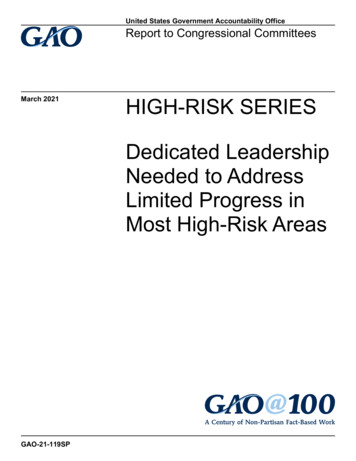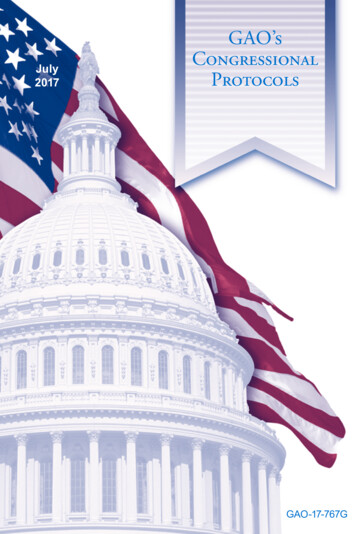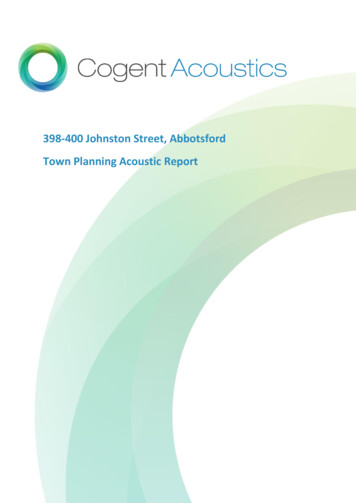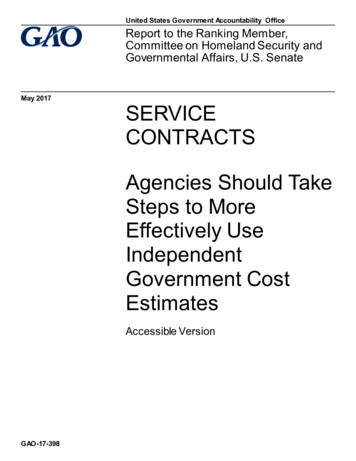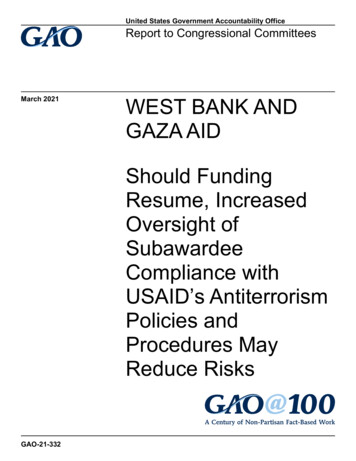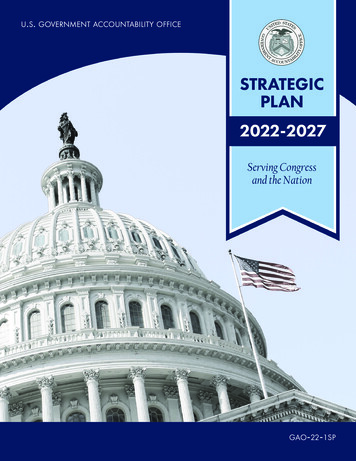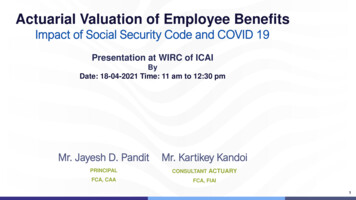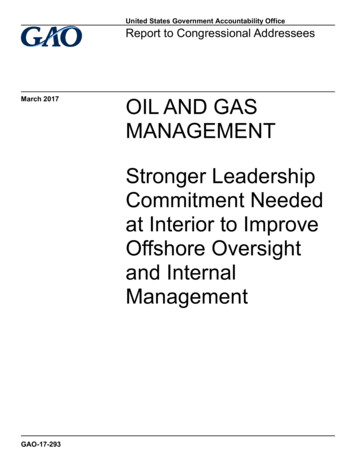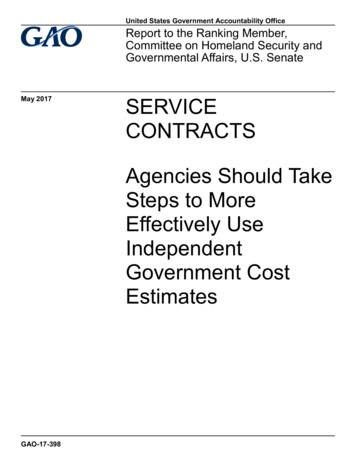
Transcription
United States Government Accountability OfficeReport to the Ranking Member,Committee on Homeland Security andGovernmental Affairs, U.S. SenateMay 2017SERVICECONTRACTSAgencies Should TakeSteps to MoreEffectively UseIndependentGovernment CostEstimatesGAO-17-398
May 2017SERVICE CONTRACTSAgencies Should Take Steps to More Effectively UseIndependent Government Cost EstimatesHighlights of GAO-17-398, a report to theRanking Member, Committee on HomelandSecurity and Governmental Affairs, U.S.SenateWhy GAO Did This StudyWhat GAO FoundIGCEs are the government’s bestestimate of a contract’s potentialcosts—an important tool for bothprogram and contracting officials toprovide information when planning forand awarding contracts. IGCEs areparticularly critical for servicecontracts—accounting for more than 270 billion in government contractspending in fiscal year 2015—toensure the costs associated with laborare fully understood.Officials at the departments in GAO’s review—Defense, Homeland Security,Health and Human Services, Education, Labor, and Housing and UrbanDevelopment—developed independent government cost estimates (IGCE) for 62of the contracts GAO reviewed. All of the departments in GAO’s review havesome guidance on IGCEs available—ranging from regulation to handbooks tochecklists—with different emphasis on whether an IGCE is required. GAO foundsome cases where guidance dictated that an IGCE should have been prepared,but was not. According to officials, one reason for not preparing an IGCE wasthat the procurement was a task order issued under an existing contract. Federalinternal control standards state that agencies should communicate qualityinformation to achieve their objectives, such as including clear guidance foracquisition planning.GAO was asked to review federalagencies’ use of IGCEs. This reportexamines the extent to which (1)selected departments developedIGCEs for service contracts and (2)selected departments’ IGCEs wereuseful in supporting the acquisitionplanning process.To conduct this work, GAO selectedsix departments that in fiscal year2015, the most current data available,were among the top spenders onservices or had a high percentage ofspending on services. GAO reviewed arandom non-generalizable sample of76 service contracts, and comparedIGCEs and related documentation withGAO’s cost estimating guide. GAOalso conducted interviews withcontracting and program officials.In the 62 contracts GAO reviewed with IGCEs, the IGCEs’ use in acquisitionplanning varied—from determining funding needs to determining pricereasonableness. The usefulness of an IGCE to a contracting officer depends inpart on its supporting documentation, but most IGCEs did not document datasources and methodologies used (see figure).Well-Documented Independent Government Cost Estimates (ICGE), per GAO’s CostEstimating GuideWhat GAO RecommendsTo improve the usefulness of IGCEs,GAO is making five recommendations,including that departments revise orclarify guidance or provide moretraining to help ensure IGCEs areprepared when required and are welldocumented with clearly-stated datasources and methodologies. All sixdepartments agreed with GAO’srecommendations.View GAO-17-398. For more information,contact Marie Mak at (202) 512-4841 ormakm@gao.gov.Lack of documented data sources and methodologies in an IGCE putscontracting officers at a disadvantage and could lead to additional, inefficientsteps to validate IGCEs. Only two of the agencies in GAO’s review had explicitguidance on what details to document in IGCEs, but officials were not alwaysfamiliar with the available guidance. Instead, according to the officials GAOspoke with, they often follow program office practices and noted that training didnot address how to develop and document an IGCE. GAO’s cost estimatingguidance and federal internal control standards emphasize the need fordocumentation, with GAO’s guidance stating that well-documented costestimates should describe the data sources used, underlying assumptions, andthe estimating methodologies used to derive costs. Without clear guidance ormore training on documentation of data sources and methodologies,departments may not be taking full advantage of this important acquisition tool.United States Government Accountability Office
ContentsLetter1BackgroundMost of the Contracts Reviewed Included IGCEs, but GuidanceVaried on Whether IGCEs Were RequiredThe Usefulness of IGCEs in Acquisition Planning Varied, andMost Did Not Include Supporting DocumentationConclusionsRecommendations for Executive ActionAgency Comments and Our Evaluation13262729Appendix I.Objectives, Scope and Methodology30Appendix IIComments from the Department of Defense33Appendix IIIComments from the Department of Education35Appendix IVComments from the Department of Health andHuman Services37Appendix VComments from the Department of Homeland Security39Appendix VIComments from the Department of Housing andUrban Development41Appendix VIIComments from the Department of Labor43Appendix VIIIGAO Contact and Staff Acknowledgments45Page i36GAO-17-398 Service Contracts
TablesTable 1: Service Contracts and Task Orders Selected, byDepartmentTable 2: Department Guidance on Independent Government CostEstimates (IGCE)Table 3: Service Contracts and Task Orders Selected, byDepartment21131FiguresFigure 1: Independent Government Cost Estimates (IGCE) in theAcquisition Planning and Contracting ProcessFigure 2: Independent Government Cost Estimates (IGCE)Available for Service Contract and Task Order FilesFigure 3: Contracts’ Independent Government Cost Estimates(IGCE) Compared to Estimated Values at AwardFigure 4: Well-documented Independent Government CostEstimates (IGCE) in Selected Contract Files, per GAOCost Estimating GuidePage ii571622GAO-17-398 Service Contracts
CEContracts & Acquisitions ManagementContracting Officer’s RepresentativeDepartment of DefenseDepartment of Homeland SecurityFederal Acquisition RegulationFederal Procurement Data System – Next GenerationGeneral Services AdministrationDepartment of Health and Human ServicesDepartment of Housing and Urban Developmentindefinite delivery indefinite quantityindependent government cost estimateThis is a work of the U.S. government and is not subject to copyright protection in theUnited States. The published product may be reproduced and distributed in its entiretywithout further permission from GAO. However, because this work may containcopyrighted images or other material, permission from the copyright holder may benecessary if you wish to reproduce this material separately.Page iiiGAO-17-398 Service Contracts
Letter441 G St. N.W.Washington, DC 20548May 17, 2017The Honorable Claire McCaskillRanking MemberCommittee on Homeland Security and Governmental AffairsUnited States SenateDear Senator McCaskill:In fiscal year 2015, federal agencies obligated more than 270 billion, or62 percent, of the government’s contract spending on service contracts tohelp achieve their missions. Independent government cost estimates(IGCE)—the government’s best estimate of a contract’s potential costs—are an important tool throughout the process of planning and awardingservice contracts. The IGCE supports efforts to ensure that the cost ofmeeting the government’s requirements for the good or service beingacquired are known. IGCEs are also used by contracting officials tocompare offerors’ proposed prices, determine whether proposed contractprices are reasonable, and to support contract price negotiations.You asked us to review agencies’ policies and use of IGCEs in servicecontracts. This report examines the extent to which (1) selecteddepartments developed IGCEs for service contracts, and (2) selecteddepartments’ IGCEs were useful in supporting the acquisition planningprocess.To assess the extent to which IGCEs were developed for selected servicecontracts and were useful in supporting the acquisition planning process,we reviewed a random, non-generalizable sample of 76 contracts from sixfederal departments—the Departments of Defense, Education, Healthand Human Services, Homeland Security, Housing and UrbanDevelopment, and Labor—that obligated money for service contracts infiscal year 2015, the most current data available at the time of our review.Specifically, the six departments selected either had among the highesttotal obligations for service contracts, or spent a large percentage of theirobligations for services during that time frame, according to data from theFederal Procurement Data System-Next Generation (FPDS-NG). 1 We1The Federal Procurement Data System–Next Generation (FPDS-NG) is a system forcollecting, developing, and disseminating procurement data. Agency reportingrequirements for FPDS-NG are in Federal Acquisition Regulation (FAR) subpart 4.6.Page 1GAO-17-398 Service Contracts
determined that FPDS-NG was sufficiently reliable for the purpose ofselecting departments based on their fiscal year 2015 obligations forservice contracts. Within the departments, we also used FPDS-NG toselect contracts from the agencies or contracting components thataccounted for a large share of service contracting obligations, whichinclude the Army and Air Force within the Department of Defense.Overall, we selected 76 contracts and task orders in total—between 10and 16 from each department—as shown in table 1. Of the 76, 37 weretask orders under indefinite delivery indefinite quantity (IDIQ) contracts—which are contracts that do not specify a precise amount of services to beprovided, but allow for issuing specific tasks to be performed by issuingorders, as needed. 2Table 1: Service Contracts and Task Orders Selected, by DepartmentDepartmentContractsselectedTask ordersselected1393Contracts and AcquisitionsManagement51Contracting componentDefenseArmyAir ForceEducationFederal Student Aid46Health and HumanServicesNational Institutes of Health73Homeland SecurityOffice of Procurement Operations35Customs and Border Protection2464823937Housing and UrbanDevelopmentLaborEmployment and TrainingAdministrationTotalSource: GAO analysis of agency documents. I GAO-17-398The 76 contracts and task orders were selected from randomly-generatedlists for each agency or component, which included all service awardswith obligations greater than the simplified acquisition threshold—2Federal Acquisition Regulation (FAR) 16.504 provides more information on indefinitedelivery indefinite quantity contracts.Page 2GAO-17-398 Service Contracts
150,000—in fiscal year 2015. 3 We chose a mix of competed (39) andnon-competed (37) awards, as well as different contract types andservices. We also selected at least one award at each agency with morethan 10 million in obligations in fiscal year 2015.For each contract and task order selected, we requested and reviewedavailable contract file documentation, including the IGCE, the statementof work, and acquisition planning documents to understand how the IGCEwas developed. We also interviewed program and contracting officials foreach contract to determine how the IGCEs were developed and used,and reviewed available guidance on IGCEs. We compared the IGCEs tostandards in GAO’s cost estimating guide and the departments’ guidanceon IGCEs to federal internal control standards. 4We conducted this performance audit from December 2015 to May 2017in accordance with generally accepted government auditing standards.Those standards require that we plan and perform the audit to obtainsufficient, appropriate evidence to provide a reasonable basis for ourfindings and conclusions based on our audit objectives. We believe thatthe evidence obtained provides a reasonable basis for our findings andconclusions based on our audit objectives.BackgroundAn IGCE is an estimate of the expected cost of a contract or task order.IGCEs are developed by government personnel before solicitingcontractor proposals or making contract awards. 5 A quality IGCE cansupport both program and contracting officials throughout the phases ofthe acquisition planning and award process. As shown in figure 1, in thepre-solicitation phase of a procurement, IGCEs help program offices—which for the purposes of this report refer to the offices or requiringactivity that need the service—confirm that their estimated costs alignwith the contract requirements for the service being acquired. Further,IGCEs help establish contract cost goals to ensure funding is available to3Agencies may use simplified acquisition procedures to purchase goods and serviceswhere the aggregate amount does not exceed 150,000. FAR 2.101 and 13.000.4GAO, Cost Estimating and Assessment Guide Best Practices for Developing andManaging Capital Program Costs, GAO-09-3SP (Washington, D.C.: Mar. 2009) andStandards for Internal Control in the Federal Government, GAO-14-704G (Washington,D.C.: Sept. 2014).5The IGCE can be part of a broader cost estimating process for programs, which sumsindividual cost elements to establish future program costs. See GAO-09-3SP.Page 3GAO-17-398 Service Contracts
meet expected contract costs. Moreover, although not required by theFederal Acquisition Regulation (FAR) for most service contracts, IGCEscan support contracting officials in establishing cost or price objectives ifthey enter into contract negotiations. 6 The FAR identifies the IGCE as oneof several tools available to establish that the contractor’s cost or price isreasonable, and while determining price reasonableness by comparingproposed prices in a competition to one another or by comparingproposed prices to historical prices paid for the same or similar items ispreferred, the FAR provides the contracting officer discretion on when touse what tools appropriate to the acquisition. 76The Federal Acquisition Regulation requires independent government estimates ofconstruction costs for contracts exceeding the simplified acquisition threshold. FAR36.203.7FAR 15.404-1(b)(2)-(3). FAR Subpart 15.4 defines price as cost plus fee or profitapplicable to the contract type.Page 4GAO-17-398 Service Contracts
Figure 1: Independent Government Cost Estimates (IGCE) in the Acquisition Planning and Contracting ProcessPage 5GAO-17-398 Service Contracts
Service contracts involve the time and effort of the contractor to performan identifiable task, such as test and evaluation or facilities management,rather than furnish a good or product. Service contract IGCEs may bebased on unit pricing—such as prices based per square foot like janitorialservices—or individual cost elements. IGCEs for cost elements may bebased on projected direct labor costs. Direct labor costs take into accountthe categories of labor—for example, a senior program manager or anentry-level research assistant—needed to meet the requirements of theservice acquired, as well as the number of hours required from each laborcategory and the associated rates. IGCEs for service contracts may alsoinclude additional cost elements, such as: Indirect costs, which can include contractor overhead and fringebenefits, such as employee health insurance costs, if not incorporatedinto labor rates, and contract fee, if applicable; and Other direct costs, which may include materials required or travel.IGCEs can be developed for individual task orders under IDIQ contractsas well as the base IDIQ contract. When IGCEs based on cost elementsare developed for task orders, some elements of the estimate, such aslabor rates associated with certain labor categories, may be establishedin the base IDIQ contract. Depending on the estimating method used, thetask order’s IGCE may still need to estimate the level of effort—such asnumber of people or hours expected—across the different laborcategories to perform the required tasks.Most of the ContractsReviewed IncludedIGCEs, but GuidanceVaried on WhetherIGCEs WereRequiredFor the majority of the service contracts and orders we reviewed, anIGCE was prepared. In cases where no IGCE was prepared, agencyofficials generally told us that an IGCE was not necessary for task ordersunder an IDIQ contract, or that the contract work was for research anddevelopment, for which it was too difficult to predict the costs. However,we found cases where agency officials prepared IGCEs for task ordersand for research and development contracts and found them useful.IGCEs are often developed by the program office’s contracting officerrepresentative—who is assigned to support contracting officers inmanaging contractor performance—with varying levels of input andreview from program office staff. All of the departments in our review havesome guidance on IGCEs available—ranging from regulation tohandbooks to checklists—with different emphasis on whether an IGCE isrequired. We found some cases where guidance dictated that an IGCEshould have been prepared, but was not.Page 6GAO-17-398 Service Contracts
Most Contracts IncludedIGCEs; Others LackedIGCEs for SeveralReasonsAlthough the FAR does not require IGCEs for most service contracts, 62of the 76 service contract files we reviewed included them, as shown infigure 2. These include awards ranging from a 600,000 task order forinformation technology services to a 163 million contract to supportvaccine research and development.Figure 2: Independent Government Cost Estimates (IGCE) Available for ServiceContract and Task Order FilesAgency officials cited various reasons to explain why 14—half of whichwere not competed—of the 76 contracts and task orders did not haveIGCEs. Officials generally could not find the IGCE, or stated that they didnot develop IGCEs for task order awards from IDIQ contracts or did notdevelop IGCEs for research and development services because therequirements are too difficult to estimate. Specifically we found:Page 7GAO-17-398 Service Contracts
Task orders: For six task orders under IDIQ contracts within theDepartments of Education, Defense (DOD), and Housing and UrbanDevelopment (HUD), officials noted that they did not develop IGCEsat the task order level. For two from the Department of Education,officials explained that the task orders—one valued at 32.5 millionand the other at 433,000—were for volume-based loan services,where pricing was established with the contractors when the baseIDIQ contract was awarded. According to senior Department ofEducation officials, the contracting officer determined that creatingIGCEs at the task order level was not an efficient use of time andresources because pricing per loan was fixed at the base contractlevel. In another example, an Air Force contracting official, referring toa 1.8 million task order from a noncompetitive IDIQ contract forengineering and technical services, indicated that IGCEs for relatedtask orders were not needed because the Air Force has beencontracting for the services for more than 20 years and the taskorders are routine at this point. Research and development: One competed contract and onenoncompetitive task order we reviewed without IGCEs were DODawards for research and development services. Officials explainedthat since requirements are not always fully understood before theproposals are received and analyzed—even in a noncompetitiveprocurement—it is difficult to develop useful IGCEs. For example, fora competed Air Force award, officials told us they relied on thecontractors’ innovation to address requirements and the programoffice reviewed the proposals to ensure approaches were technicallysound and achievable.However, in other instances, we found that agencies awarding taskorders and research and development contracts that had developedIGCEs and found them to be useful. For example: Task orders: We reviewed 27 task orders from IDIQ contracts whereIGCEs were developed. Army officials said they develop task orderIGCEs even when the labor rates are pre-negotiated in the base IDIQcontract, in part because the IGCEs include other estimated costs,such as travel expenses and other direct costs, which help contractingofficials understand the services the program office expects toreceive. Officials for several task orders we reviewed cautioned that itis important for them to develop separate IGCEs specific to each taskorder because the base IDIQ contract may not contain the level ofdetail necessary to estimate requirements at the task order level. Forexample, an IGCE for a 5.3 million DHS task order for informationtechnology included estimates for task-specific costs, such as laborPage 8GAO-17-398 Service Contracts
for equipment set-up, installation, and operation costs. The programofficial noted that these costs were not detailed in the base IDIQcontract. Research and development: Eight of the research and developmentcontract files we reviewed had IGCEs. Officials from HHS said thateven when requirements are not fully understood, some laborcategories and related elements can be estimated in advance to giveofficials points of comparison when reviewing proposals. According toDHS officials, they used the IGCE as the primary governmentestimate for the price analysis to determine price reasonablenessonce contract proposals were submitted.For most of the remaining contract awards where IGCEs were notavailable, officials told us that IGCEs had been developed but could notbe located in the contract or task order files. In some cases, the contractswere more than 6 years old and staff turnover and file transfers made itdifficult for us to obtain contract file documents. In a couple of cases,officials said they did not create IGCEs, but used other resources—suchas audited rates—to examine costs and prices.Program Offices AreGenerally Responsible forDeveloping IGCEsProgram and contracting officials share responsibility for many acquisitionplanning activities, but in the contracts we reviewed, staff in the programoffice were primarily responsible for developing IGCEs. Officials from thesix departments we met with said that the contracting officer’srepresentative (COR)—usually a person within the program office—mostoften develops IGCEs. 8 In some cases, CORs said they developedIGCEs autonomously, using their experience with prior efforts to estimatethe level of effort necessary to meet requirements needed for the servicebeing acquired. For example, for a Department of Education contractworth approximately 807,000, the COR explained that the program hadworked with the contractor on a similar effort in the past and as a result,the COR had a thorough understanding of the labor categories and laborhours necessary to meet requirements, so did not need input from othersources to determine the level of work necessary. However in manycases, CORs received input from other program office officials, such asprogram managers or subject matter experts, during the IGCE8Contractor oversight personnel are known by many names, including contracting officer’srepresentative and contracting officer’s technical representative, but their duties areessentially the same. For the purposes of this report, we refer to these personnelgenerally as contracting officer’s representatives (COR).Page 9GAO-17-398 Service Contracts
development process. According to officials, IGCEs are often reviewedand approved within program offices as one of several documents in aprocurement request, before being sent to contracting officials. Programoffice input ranges from informal discussions with peers and managers toformal acquisition planning reviews, involving multiple stakeholders.In at least four of the contracts we reviewed, officials said their IGCEswere developed with input from sources outside the program office. 9 Forexample, The Army’s Prototype Integration Facility—which supports DODprogram offices with design and development projects requiring arapid response—assists in the development of contracts by assigningtechnical advisors to serve as CORs. An official from the facility toldus the technical advisors primarily draw on experience from otherefforts to help the program offices develop acquisition planningdocuments, including the IGCE. In at least two of the contracts we reviewed, the IGCEs weredeveloped by officials who have professional cost estimatingexperience. 10 For example, a 40 million contract from Army’s FixedWing Program—which provides life-cycle management for the Army’sfleet of fixed wing aircraft—had cost estimators imbedded in theprogram to assist with development of cost estimates, includingIGCEs. According to an Army official, because the cost estimatorsdeveloped IGCEs for the various fixed wing projects, they were ableto identify similar efforts and access data to use in the development ofestimates. Similarly, the Office of Biometric Identity Management atDHS has cost and budget specialists who helped develop the IGCEfor a 5 million engineering support contract. In a 158 million sole-source HUD contract for information technologyservices, the contracting officer used a third-party contractor with costestimating expertise who was familiar with the program to develop anIGCE. According to HUD officials, the program office developed aninitial IGCE; however, the contracting officer did not think it wasadequate to support her determination of price reasonableness9We could not determine how many contracts in our review definitively used outsidesources for input into the IGCE because officials offered it on an ad-hoc basis and hadvarying levels of familiarity with how the IGCEs were developed.10The acquisition workforce established under the Defense Acquisition WorkforceImprovement Act includes 14 acquisition career fields, including cost estimating.Page 10GAO-17-398 Service Contracts
because it did not include an analysis of how the estimated costswere developed. The resulting IGCE produced by the third-partycontractor included more detailed analysis and information thatmapped to program requirements, and helped her conductnegotiations with the offeror.Department-levelGuidance Varies on Whento Prepare IGCEsAll of the departments in our review have some type of guidance onIGCEs available—ranging from regulation to COR handbooks tochecklists—with different emphasis on whether an IGCE is required.Table 2 outlines the different types of guidance available at thedepartments we reviewed.Table 2: Department Guidance on Independent Government Cost Estimates (IGCE)DepartmentGuidance Available for IGCEsDefense (DOD) Army DOD Contracting Officer’s Representative (COR) HandbookDOD Instruction 5000.74 for Defense Acquisition of ServicesArmy Federal Acquisition Regulation Supplement part 5107Air ForceEducation Contracts and Acquisitions Management Procurement PackageaChecklistHealth and Human Services (HHS) HHS Directive for Acquisition PlanningHomeland Security (DHS) DHS Acquisition ManualDHS COR Essential Element Guidebook Housing and Urban Development Labor Acquisition Instruction 15-04 and Matrix for Requisition PackagesOffice of the Chief Procurement Officer, 15-04 – Acquisition BestPractices, Cost Realism AnalysisIndependent Government Cost Estimate (IGCE) GuidanceSource: GAO analysis of department documents. GAO-17-398aContracts & Acquisitions Management (CAM), in the Office of the Chief Financial Officer, is one ofthe two contracting activities within the Department of Education.Three of the departments we reviewed—HHS, DHS, and the Departmentof Labor—expressly address IGCEs in documents such as directives,acquisition manuals, or guidebooks. For example, the HHS Directive forAcquisition Planning states that IGCEs are required as part of theacquisition plan, which is required for acquisitions greater than 150,000.The DHS Acquisition Manual requires IGCEs for most proposednegotiated acquisitions although it allows for several exemptions, such asfor acquisitions of commercial items and modifications to resolve costoverruns. The Department of Labor developed a guidebook specific toIGCEs, which states that cost or price estimates are required for awardsPage 11GAO-17-398 Service Contracts
above the simplified acquisition threshold. The contracts and task orderswe reviewed from these departments all included IGCEs.At the Department of Education, the guidance regarding IGCEs is lessclear and our review found that IGCEs were not always developed. TheDepartment does not have department-level guidance, but the Contractsand Acquisitions Management (CAM) group—which is one of twocontracting activities at the Department—has a checklist for procurementpackages that references IGCEs. Education officials told us the CAMguidance is available for use by the other contracting activity (FederalStudent Aid), but it is not required. Five of the 16 Education task ordersand contracts in our review—all of which were from Federal StudentAid—did not have IGCEs.Within HUD, we found two contracts without IGCEs, and department-levelguidance varied. Specifically, HUD’s acquisition best practices for costrealism analysis notes the importance of the IGCE in acquisition planningbut does not state under what conditions they are required. 11 Morerecently, HUD developed a procurement request checklist listing IGCEsas one of several required documents when program offices initiate newprocurements.DOD—including Army and Air Force—has different levels of guidancewith respect to IGCEs, but it was not always followed. For example, theArmy FAR supplement is clear that an IGCE is required for everyprocurement action over the simplified acquisition threshold, but 3 of the10 Army awards we reviewed did not have IGCEs. Although the Air Forcedoes not have its own guidance for IGCEs, the DOD COR handbook isapplicable to Air Force procurements and requires IGCEs over thesimplified acquisition threshold, but only 2 of the 6 task orders wereviewed had an IGCE. Further, DOD Instruction 5000.74 references theuse of IGCEs in service contracts, but does not clearly require them. 12Federal internal control standards state that agencies should11Cost realism analys
that the procurement was a task order issued under an existing contract. Federal . departments may not be taking full advantage of this important acquisition tool. View GAO -17 398. For more information, contact Marie Mak at (202) 512-4841 or . include the Army and Air Force within the Department of Defense. Overall, we selected 76 .
